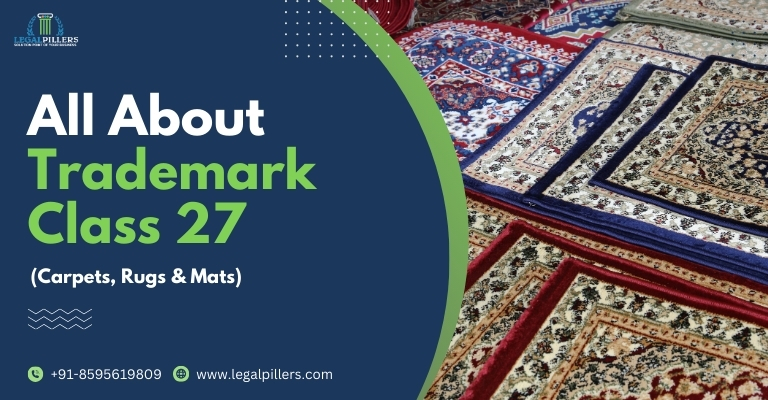
Table of Contents
All About Trademark Class 27
Trademark Class 27 is a classification used by intellectual property offices, including the United States Patent and Trademark Office (USPTO) or the World Intellectual Property Organization (WIPO), to categorize goods and services for trademark registration purposes. In Class 27, the focus is on products related to floor coverings and wall hangings, including carpets, rugs, mats, linoleum, and other materials used for covering floors and walls. When a business wants to protect its brand name or logo associated with these types of products, it will file for trademark registration in this class to safeguard its exclusive rights and prevent others from using a similar trademark in the same category.
Important goods included in Trademark Class 27
Trademark Class 27 mainly includes the products intended to be added as coverings to previously constructed floors and walls. The goods that have been included in the class 27 of trademark are as given below-
- Automobile carpets
- Mats being floor coverings, for instance, bath mats, door mats, gymnastic mats, yoga mats
- Artificial turf
- Wallpaper, including textile wallpaper
Goods does not included in Trademark Class 27
- Floors, floorings, and floor tiles made of metal (included in class 6)
- Floors, floorings, and floor tiles, not of metal (included in class 19)
- Wooden floorboards (included in class 19)
- Electrically heated carpets (included in class 11)
- Geotextiles (included in class 19)
- Mats for infant playpens (included in class 20)
- Wall hangings of textiles (included in class 24)
List of popular examples of Trademark Class 27
- Obeetee: Carpets, rugs, mats, matting, wall hangings, etc.
- Kaleen: Carpets, floor coverings, rugs, dhurries, etc.
- National Handloom Corporation: Carpets, rugs, mats and, matting, etc.
- The Weaver: Carpets, rugs, mats, linoleum, etc.
- Strauss Go Play: Yoga mats, plastic mats, carpets, rugs
- Yogarise: Yoga mats
- Boldfit: Yoga mats
- OJS: Yoga mats, carpets, rugs, etc.
- Solara: Yoga mats, bags for yoga mats, non-slip yoga blankets, etc.
List of goods classified under Trademark Class 27
A
- Artificial turf
B
- Bath mats
C
- Carpet underlay
- Carpet/ rugs
- Carpets for automobiles/ automobile carpets
D
- Doormats
F
- Fire-resistant, for fireplaces and barbecues
- Floor coverings
- Floor mats
G
- Gymnastic mats/ gymnasium mats
L
- Linoleum floor coverings
- Linoleum tiles [floor coverings]
M
- Mats of woven rope for ski slopes
- Mats
N
- Non-slip mats
P
- Prayer mats
R
- Reed mats
T
- Tatami mats
- Textile wall coverings
- Textile wallpaper
V
- Vinyl floor coverings
W
- Wall hangings, not of textile
- Wallpaper
Y
- Yoga mats
This trademark class is important for businesses that manufacture or sell floor coverings made of textile materials. It includes a wide range of products, such as carpets, rugs, mats, and linoleum. These goods are often used in homes, offices, and other commercial spaces to add aesthetic appeal, provide comfort, and protect floors from wear and tear.
Textile wall hangings and wallpaper made of non-paper materials are also included in this class. Textile wall hangings are decorative pieces that can be hung on walls to add a touch of elegance and sophistication to a room. Non-paper wallpaper, on the other hand, is made of materials such as vinyl or fabric and is often used in commercial spaces such as hotels, restaurants, and offices.
Artificial turf is another product included in this Trademark Class. It is a popular alternative to natural grass in sports fields and other outdoor spaces, as it requires less maintenance and provides a consistent playing surface. Artificial turf is also used in residential and commercial landscaping to create a low-maintenance and durable outdoor space. It is important to note that not all floor coverings are included in Class 27.
Conclusion
Trademark Class 27 is an important category within the international trademark classification system. It primarily covers goods related to floor coverings, wall hangings, and textiles, including carpets, rugs, mats, linoleum, and other similar products. This class is crucial for businesses and individuals looking to protect their trademarks associated with these types of goods.
When filing for a trademark in this class, it is essential to ensure that your mark is distinctive and does not infringe upon existing trademarks in the same class. Conducting a comprehensive trademark search and seeking legal advice, if necessary, can help you navigate the trademark registration process successfully.
Overall, understanding and utilizing this class of Trademark effectively can provide valuable protection for your brand and its associated products in the market. However, it is essential to stay updated on any changes or updates to trademark law and regulations that may impact your rights in this class.
At LegalPillers, we are here to help you in navigating the complexities of trademark registration and classification effectively, making sure that your brand is adequately safeguarded within this important class. Choose LegalPillers as your trusted partner for classifying and registering the trademark under this class.
(FAQs) related to Trademark Class 27
1. What is Trademark Class 27?
● Trademark Class 27 is one of the 45 classes used for trademark classification under the Nice Classification system. It includes goods related to floor coverings, wall hangings, and textiles, such as carpets, rugs, mats, linoleum, and similar products.
2. Why is it important to classify goods under Class 27?
● Properly classifying your goods under Class 27 is essential for trademark registration and protection. It ensures that your trademark is associated with the specific category of goods you produce or sell, providing legal protection and exclusivity within that category.
3. What are some examples of goods in Class 27?
● Goods in Class 27 include carpets, rugs, mats, linoleum, artificial turf, wall hangings, wallpaper, bath mats, and similar products used for covering floors or walls.
4. Can I file a trademark in multiple classes, including Class 27?
● Yes, you can file a trademark in multiple classes if your business or brand deals with goods or services that fall into different categories. Filing in multiple classes allows you to protect your trademark across various product or service lines.
5. How do I determine if my product falls under Class 27?
● To determine if your product belongs to Class 27, you should review the specific goods and services description in the Nice Classification system. If your product is similar to those listed under Class 27, it likely falls within this class.
6. What are the steps to register a trademark in Class 27?
● The steps for trademark registration in Class 27 typically involve conducting a trademark search to ensure your mark is unique, preparing and filing a trademark application, paying the required fees, and working with the relevant trademark office to complete the registration process.
7. How long does a trademark registration in Class 27 last?
● The duration of trademark registration varies by country but typically lasts for ten years, renewable indefinitely as long as you continue to use and protect your trademark.
8. Can I license or sell my trademark rights in Class 27?
● Yes, you can license or sell your trademark rights in Class 27 to other individuals or businesses. It can be a source of revenue and strategic partnerships.
9. What happens if someone infringes on my trademark in Class 27?
● If someone infringes on your trademark in Class 27, you have the legal right to take action against them, including sending cease and desist letters, pursuing legal action, and seeking damages.
10. Do I need legal assistance for Class 27 trademark registration?
● While it is possible to file a trademark application on your own, seeking legal assistance from a trademark attorney or agent is often advisable, especially if you are unfamiliar with the registration process or dealing with complex issues.
11. Can I use a similar trademark to one already registered in Class 27?
● Generally, using a similar trademark to one already registered in Class 27 can lead to trademark infringement issues. It is advisable to conduct a comprehensive trademark search to identify potential conflicts before attempting to register a similar mark.
12. What is the difference between Class 27 and Class 24?
● Class 27 primarily covers floor coverings and wall hangings, while Class 24 focuses on textiles and textile goods, including fabrics, bed linens, and tablecloths. Understanding the distinction is crucial when choosing the appropriate class for trademark registration.
13. Can I register a trademark for a design or pattern used on carpets or rugs in Class 27?
● Yes, you can register a trademark for a unique design or pattern used on carpets or rugs, provided it meets the criteria for trademark registration, such as being distinctive and not generic.
14. Are there any restrictions on the use of trademarks in Class 27?
● Trademarks registered in this class are protected for the specific goods they cover. The owner has the exclusive right to use the mark on those goods. However, it is essential to use the mark consistently and actively to maintain and enforce trademark rights.
15. How do I protect my trademark internationally in Class 27?
● If you want to protect your trademark internationally in this class, you can consider filing an international trademark application under the Madrid Protocol. It allows you to seek protection in multiple countries by submitting a single application.
16. Can a descriptive term be registered as a trademark in Class 27?
● Descriptive terms are generally more challenging to register as trademarks. To register a descriptive term in this class of trademark, you may need to demonstrate that it has acquired distinctiveness through extensive use and recognition in the market.
17. What is the cost associated with trademark registration in Class 27?
● The cost of trademark registration in this class varies by country and jurisdiction. It includes filing fees, attorney fees (if you choose to hire one), and maintenance fees. It is advisable to consult with the relevant trademark office or a legal professional for cost details specific to your situation.
18. Can I change the goods covered by my trademark registration in Class 27?
● You may be able to amend the goods covered by your trademark registration in this class under certain circumstances. Consult with your trademark attorney or the relevant trademark office for guidance on making amendments.
19. How can I enforce my trademark rights in Class 27 against infringers?
● To enforce your trademark rights in this class, you can take legal action against infringers through cease and desist letters, negotiation, or litigation. Consult with a trademark attorney to determine the best course of action based on the specific circumstances.
20. What is the “use in commerce” requirement for trademark registration in Class 27?
● In many jurisdictions, including the United States, trademark registration in this class requires demonstrating “use in commerce”. It means you must use the trademark on the specified goods in the ordinary course of trade to be eligible for registration.


Leave a Reply